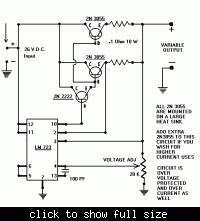logmode
Newbie level 5

- Joined
- Aug 30, 2011
- Messages
- 9
- Helped
- 0
- Reputation
- 0
- Reaction score
- 0
- Trophy points
- 1,281
- Activity points
- 1,354
Hi, I want to build a power supply @ 25v a/c in and a variable 0- 20vdc, 10a max out. So that’s the plain. After the rectifier, I want to put a capacitor to smooth out the pulse. Now my question is: Does anyone know the formula to find the UF capacitance? Plus and minus information on error sizing would greatly appreciated, for since my current will be sometime low, and sometimes high (different loads), how do I use the formula for that?
Thank you
Thank you




